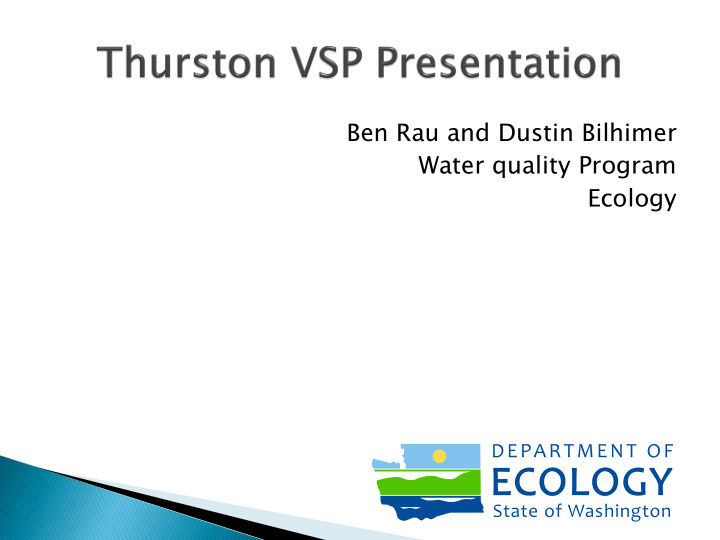



Ben Rau and Dustin Bilhimer Water quality Program Ecology
Authorities Thurston County overview Chehalis River Watershed TMDLs
Federal Clean Water Act ◦ Delegation to Ecology ◦ NPDES Permits ◦ Section 303d Water Quality Standards TMDLs (Total Maximum Daily Load) ◦ Section 319-Nonpoint Program State Water Pollution Control Act ◦ Authority to administer Federal CWA delegated roles ◦ State Waste Discharge Permits ◦ Discharge Prohibition
TMDLs ◦ Upper Chehalis Bacteria ◦ Upper Chehalis Temperature ◦ Upper Chehalis Dissolved Oxygen ◦ Totten, Eld, and Skookum Inlets Tributaries ◦ Henderson Inlet Watershed Multiparameter ◦ Nisqually Watershed Bacteria and DO ◦ Deschutes River Multiparameter-In Development
Summary of Projects and Links to Documents http://www.ecy.wa.gov/programs/wq/tmdl/ChehalisIndex.html
Fish-able Dig-able Swim-able Live-able Drink-able Economically Viable Sustainable
1996 96 Upper Chehalis River Basin DO, BOD, Ammonia rev.20 2000 00 Dissolved Oxygen TMDL 200 2001 Upper Chehalis River Basin Temperature, Effective Temperature TMDL Shade 200 2004 Upper Chehalis River Bacteria TMDL Fecal Coliform Bacteria 200 2004 The Chehalis/Grays Harbor DO, Temperature, Watershed Multi-parameter TMDL Fecal Coliform Bacteria Detailed Implementation Plan (DIP)
• The reason for significant investments in Centralia and Chehalis STPs • WLA for WestFarm Foods • Nonpoint LAs shown as Percent Reductions needed. Load Allocations for Load Allocations for BOD Ammonia
• Identified WLA for all existing point sources • LA for Nonpoint sources included reach-based percent riparian shade improvements; and mean tributary width-to- depth ratios to achieve stable and narrower/deeper channels.
• Used the Statistical Roll-back method to determine percent reductions of FCB needed to meet WQ standards. • LAs for nonpoint sources apply to the LA Compliance Areas (LACAs) in the map.
Expressly identifies role of CBP and Ecology to coordinate monitoring, evaluate wq monitoring data, and so that progress of implementation actions will occur routinely (p39). Includes: Management Roles, Activities, and Schedules, performance measures and targets, monitoring plan, etc.
• Land use activities may have specific BMPs needed, but most all include functioning riparian areas • Residential parcels in rural areas often include “hobby farm” activities that need similar BMPs as parcels in more intensive agricultural uses.
TMDL Effectiveness Study Approach ◦ Assess current water quality ( wq listing criteria ) ◦ Account for new sources ◦ Compare current water quality with Load and Wasteload Allocations… Were targets met? ◦ Identify where BMP investments were made ◦ Try to correlate water quality improvements with BMPs implemented ◦ Identify Education and Outreach Successes ◦ Revise allocations to reflect current conditions Report to EPA and the public
Low percent reduction allocations for bacteria might indicate a lower level of implementation is needed in some tributary watersheds, but there may be high- priority problems that still need to be addressed. Collaboration is critical Everybody needs to implement BMPs to protect water quality and the long-term viability of agricultural land uses and quality of life for the community.
Recommend
More recommend